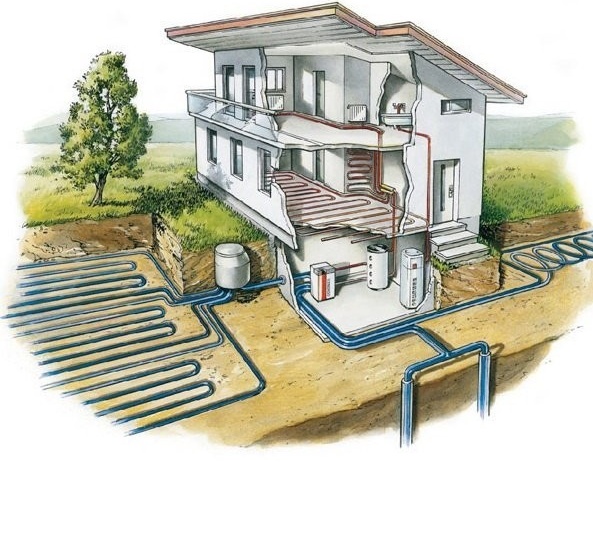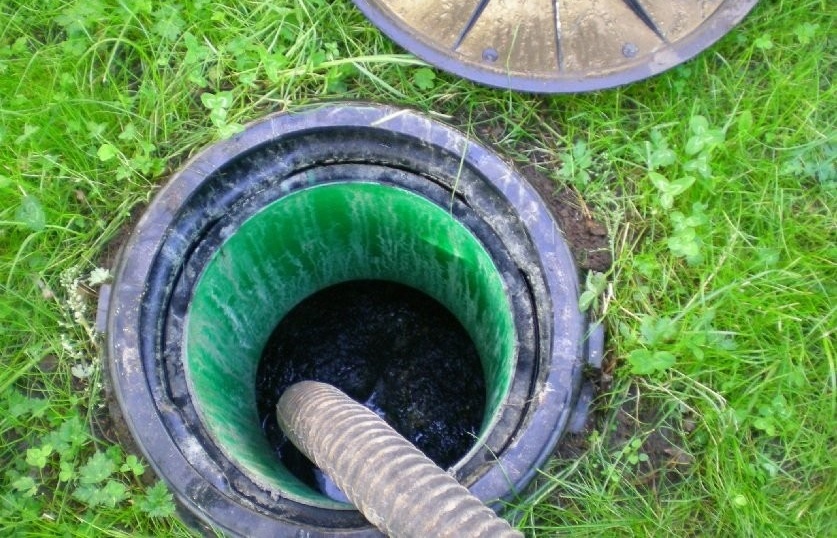Local sewerage of a country house: a comparative overview of treatment facilities
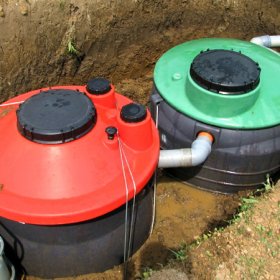
The construction of houses and towns in its pace ahead of the development of infrastructure and utilities. The construction of electric grids is not so far behind as water supply, gasification, and especially sewage. For each of these systems, there are one or two alternative options: generators, wells and wells, liquefied gas. But the sewerage of a country house has several ways of organizing: from a primitive cesspool to a deep waste treatment station, which at the outlet gives water suitable for watering plants. In this article we will consider and compare among themselves all the options.
Content
What to look at when designing?
Autonomous local sewage is a protection against the spread of unpleasant odors and harmful microorganisms. If you consider all the factors, then even a simple cesspool will be safe for the site, the cottage and its residents.
When designing a sewer system, they rely on the following indicators:
- projected water consumption;
- relief and area of a suburban area;
- location of the main water source (if there is a well or a well on the site);
- remoteness from lakes, rivers and other reservoirs;
- groundwater depth;
- climatic conditions of the area.
The condition of the system will completely depend on the quality, intensity and frequency of operation. The optimal prevention of gutter blockages will be plentiful and frequent discharge of water. The design should include revisions (small sealing hatches) and cleanings (holes in the pipe that are closed by a plug). They are located in places where there are bends and pipe connections or water changes movement.
The evolution of local sewage solutions
Septic tanks, a cesspool, biological treatment plants - all this has several options for execution and confuses the buyer when it comes to the choice. They have not only structural differences, but also vary significantly in price. The sewer manifold is classified according to several criteria.
First, choose a device diagram based on the type of waste. Depending on whether only human waste products will be disposed of, or whether water used for sanitary purposes is also required. The first case can be limited dry closet, in which sewage is mixed with peat base and composted as a result of the activity of certain types of aerobic bacteria.The processed mass is periodically replaced and can be used as fertilizer. This is the most inexpensive and compact option for local sewage, albeit not the most convenient, especially in winter. All other methods of organizing local sewage can handle any type of waste.
Secondly, the functional component: the local sewage system, involves only the accumulation of wastewater or their parallel processing and purification. Simple drives are a sealed and cesspool with a filter bottom. More complex devices: septic tanks, biofilters, deep bio-purification stations and aeration tanks - relieve unpleasant odors from the site, reduce the likelihood of contamination of the water source (well or well) and at the outlet they can give out water that is almost completely purified from biological and chemical contaminants. Of course, it is not suitable for reuse for sanitary purposes, but it is completely safe for watering the garden and the garden.
Thirdly, the installation location. In vertical wastewater treatment plants, the movement of fluid through the chambers is carried out using an airlift system. This design protects the station from flooding when it rises or high groundwater levels. True, for the vertical sewage of a country house, installation errors or improper operation are fraught with clogging of airlifts and an immediate emergency. In horizontal sewage treatment plants, fluid flows naturally: when a certain level is reached, excess flows through the overflow into the next chamber. The area allocated for such local treatment facilities (VOCs) should be larger than when installing a vertical system. To facilitate access during maintenance, the stations have several hatches. According to experts, they emerge, mainly due to uneven loading and, sometimes, at the time of pumping. This is not a sentence for such structures: in order to avoid the problem, it is enough to clean the chambers of settling sludge in a timely manner.
In the video you can see an example of installing a biological treatment plant:
Aerobic treatment plants are also available on the market, the structural basis of which was taken from septic tanks. This intermediate class of equipment has improved wastewater treatment performance. However, the owners of such plants periodically need to call a cesspool machine.

Many local wastewater treatment plants require periodic sludge pumping. Therefore, when designing the sewage system and its location on the site, it is very important to ensure unhindered access of the car to the station
Cesspool: minimum functions and costs
The principle of operation of this type of treatment facilities is the accumulation of effluents from bathrooms and kitchens and their subsequent purification by soil bacteria. Crushed stone, pebbles and turf are poured at the bottom of the pit, which create the simplest drainage system. Part of the effluent is cleaned in a natural way, and the remainder is removed as necessary by the sewage machine.
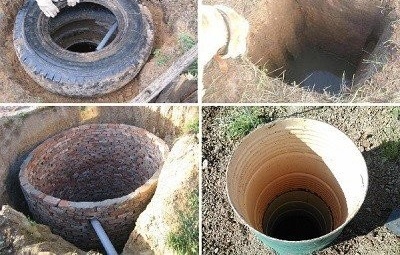
The cesspool has a huge number of options: from the pit lined with turf to a sealed iron tank. As insulating materials you can use tires, bricks, plastic and metal containers.
Upon receipt of more than 1m3 Wastewater cesspool It is “outlawed” because it does not comply with the requirements of the SNIP. Violation of sanitary standards can cost health not only to the owners of the site, but also to their neighbors. With an increase in the volume of drains, rise in groundwater or floods, poisoning of wells and wells with toxins and infections is possible.
An advanced modification of the cesspool is plastered concrete or brick walls (you can use car tires), concrete bottom, vent pipe for venting gases.According to the SNIP, its dimensions should not be more than 3 x 2 meters, and localization on the site should be at least 5 meters from the house and two from the neighbor’s fence. Homeowners often forget about organizing a free access for the cesspool machine - an annoying trifle that threatens with a sanitary catastrophe.
Environmental standards are much tougher than in the European Union. For treated wastewater discharged into natural reservoirs or on relief, the maximum permissible values of the BOD index in our country are 3-6 mg / l, while the Europeans are ready to put up with the pollution content of 15-20 mg / l.
Concrete sump well system
Local sewage of this type assumes the presence of at least two wells (as a rule, all are limited to two). The first is intended for primary wastewater treatment, and the second is for post-treatment. It should also play the role of drainage, although it is desirable to install a third drainage well, with layers of rubble and pebbles laid.
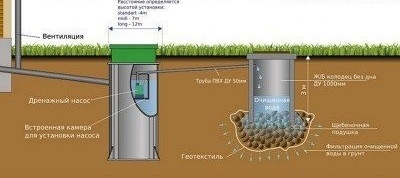
In order for the sump well system to work correctly, the second or third well must be laid with pebbles and turf and perform the function of drainage
The installation of rings can be performed without the involvement of specialists. True, it may be necessary to call special equipment to raise and lower concrete elements into the ground.
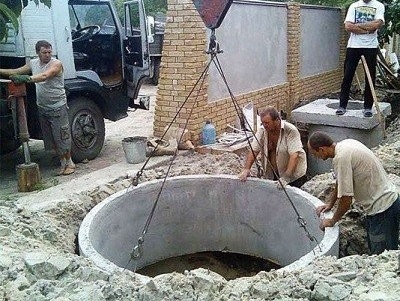
It is possible to install concrete rings without involving special equipment, but there is a risk of damage to the integrity of the surface. this will accelerate the destruction of concrete and shorten the life of the sump well
Strength and long service life, a large selection of rings of different sizes, protection against septic tank ascent (heavy concrete rings will not emerge during spring floods) and, of course, the ability to independently determine the shape, volume and depth of the settling chamber are weighty arguments in favor of settling wells . The disadvantages of this option are: leaky joints of the rings, the need to call a cesspool machine and providing free access, the cost of calling special equipment to move the rings into the pit.
Plastic wells - an alternative to concrete
The principle of operation is the same as that of sumps made on the basis of concrete rings. Here the problem of tightness is solved, there is the possibility of increasing the depth without additional sections (we are talking about corrugated execution). Most of the wells have a built-in ladder to simplify the descent.
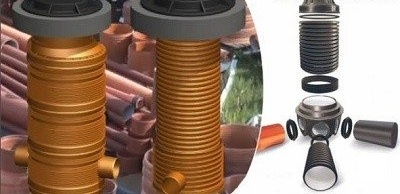
Plastic wells, of course, need to be protected from ascent, but only they can change in volume, making it possible to quickly adapt to changes in the number of residents
The only drawback is the "buoyancy" of the design. The problem is solved by pouring concrete mortar to the bottom.
Mechanical septic tank - an inexpensive and environmentally friendly option
The storage septic tank is a two-, three- or four-chamber construction, in which wastewater is filtered in stages. First, they settle and clarify, and then organic compounds are processed by anaerobic bacteria. Solid fractions settle in the first chamber, the liquid component flows into the next. At the exit from the final tank, the treated effluents enter a drainage field (sand and gravel) for natural purification.
The advantages of the system include low cost, non-volatility, simplicity of the device, the absence of an unpleasant odor. The disadvantages are: sensitivity to overloads, the need for an annual inspection and call of the scavenger, periodic replacement of soil in the drainage field and the likelihood of a tank floating up when the water table rises or sludge is pumped out.
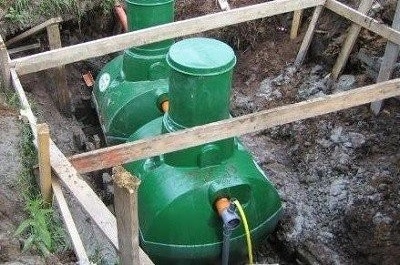
Mechanical septic tanks are finished products that give good performance in wastewater treatment. This is no longer a cesspool, but also not a bioremediation station
Biological treatment systems - the best is always expensive
BFBs are the most practical option. Reliability, durability, quality of cleaning and the possibility of using purified water - all combined in one housing.
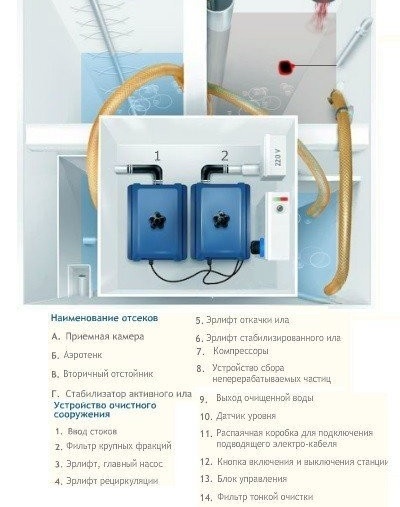
On the example, the device of the TOPAZ sewage treatment system can be seen how wastewater is treated with a biofilter and aeration tank
The design of the installation is a classic septic tank that performs the initial cleaning with anaerobic bacteria, which is supplemented by an aeration tank, a biofilter or an activator with a nitrifier and denitrifier. The biofilter allows you to completely remove residual contamination by running through expanded clay, shunguzite and biofilm.

Aerotank cleans bleached drains using sludge and a special film. This process can be accelerated by blowing liquid into the air.
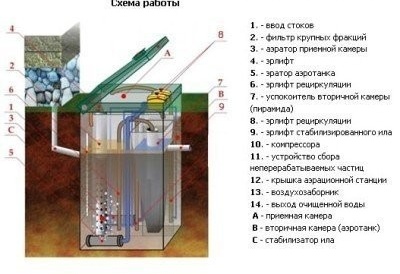
Expensive VOCs are equipped with various combinations of finishing cleaning devices that remove up to 99% of mechanical, chemical and bacterial contaminants
This class of systems has many assembly options: prefabricated structures, modular systems that are assembled directly at the installation site and are equipped in accordance with the wishes of the buyer. They are made of metal, durable plastics or concrete. The concrete case is very heavy. On the one hand, this protects the station from ascent, guarantees stable operation under difficult weather conditions and a high level of groundwater, and on the other, it causes installation difficulties. A station with a metal casing is lighter than concrete, but it requires additional costs to strengthen the structure. The least weight are local treatment facilities made of plastic. They also have the greatest resistance to corrosion. Such products are not suitable for regions with a high level of groundwater and for operation at high working pressure.
The optimal design and set of functions help to determine the specialists of companies implementing VOCs. If you are determined to make a choice yourself, pay attention to the following options:
- longevity and quality commensurate with the life span of the house;
- simplicity of design and comfort during operation;
- work efficiency with uneven flow of effluents;
- system security and service.
The class of treatment facilities and their cost depend on the combination of finishing cleaning methods. For a summer cottage, it makes no sense to purchase expensive equipment, but for a large family living all year round in a country house, VOCs with a high degree of waste treatment are preferred.
Price guidelines for the “sewer” market
Local sewage allows you to discharge and treat wastewater in a particular area using various technologies. On the market, treatment plants and reservoirs are presented in three segments: economy, standard and premium. They differ in terms of productivity, level of operating comfort, service complexity, quality of materials and components, exactingness to the territory in which they will be installed, and other characteristics.
Representatives of the cheapest and easiest segment are cesspools, sump well systems and plastic sewers. If you independently dig a hole and line the bottom with the fact that the barn is covered up, then the financial investments are equal to zero. For a conventional cesspool on a summer cottage, iron barrels of large volumes, plastic containers of 0.5-1.5 m3 have proved themselves to be excellent.
When choosing a sewer system, remember that your costs will not be limited to acquiring a tank or treatment plant. In the estimate, lay the amount that will cost the purchase of pipes, hydro and thermal insulation and accessories for connecting the house to a local sewer.
System prices. If you order a system with a sand cushion and waterproofing, then the costs increase.
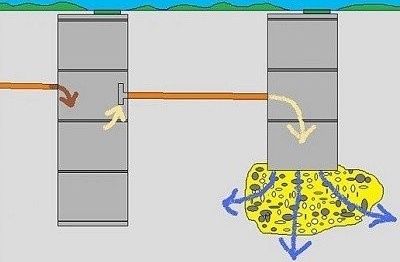
The cost of a sump well system depends on the number of rings, their diameter and the number of cleaning steps. There can be two or three (there’s no more sense in doing it), the latter, by the way, should fulfill the functions of drainage, and it’s better if it is the third well
Separately sewer wells made of plastic are inexpensive.If you contact specialized companies, then the price tag for the kit.
Standard systems include various modifications of septic tanks, such as "Sprout”,“ Uponor Sako ”and other models. They are used for sewage treatment. Some models can be supplemented with biofilters, wells or fields for filtering, then they can be attributed to the premium class not only in functionality and quality of wastewater treatment, but also in price.
The most environmentally friendly from the point of view of wastewater treatment are plants and deep biological treatment plants - this is already a premium class, including in the price segment. The average percentage of pollution removal is 90-98%, but some specimens guarantee 100%. Since Russian sanitary standards are leading in terms of their rigidity, domestic manufacturers have long mastered the three-stage treatment of wastewater. A number of products provide for the fourth stage - chlorination disinfection, as well as denitrification and nitrification (removal of nitrogen and phosphorus compounds).
These stations are either a monolithic reinforced concrete structure, or separate unit modules integrated into the system. The first include the Aspen, Favorite Plus and Green Rock installations, equipped with a biofilter for additional treatment of runoff water. Representatives of the ECO lineup (or Ecoline) consist of two sedimentation tanks, between which there is an activator with a nitrifier and a denitrifier.

Reinforced concrete case (1), intersection bypass (2), air outlet, for gas removal (3), fungus (4), bypass hole (5), reinforced concrete cover (6), service chamber (7), technological hatches (8), cast iron sewer hatch (9). A - septic zone, B - anaerobic digestion zone, C - inert loading biofilter (height from 700mm)
Modular systems are made of metal, reinforced concrete or plastic and can be equipped with various post-treatment units. For example, the Kubost 1-Bio station is supplemented with a biofilter, the Cottage-Bio system is equipped with a bioreactor, and the Kubost 1-AO is equipped with an aerotank.
The power of any of the installations varies. They are suitable both for private buildings, when up to 6-10 people live in the house, and for hotels and other residential complexes for 500-1500 people.
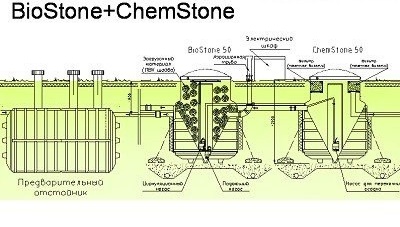
The septic tank “BioStone + ChemStone” in the “Greenrock” line is the most powerful and modern. After processing, the effluents comply with the requirements of the SNIP and can be discharged into water bodies or discharged onto the terrain. The system is regulated for different volumes of incoming waste: 5, 10 or 20 m3, which corresponds to the average water consumption for 30, 60 and 120 people, respectively
One of the most expensive on the market is the BioStone + ChemStone complex. The design provides for the presence of a sump, a bioreactor, a block for cleaning phosphorus, and stone fiber finish filters. They trap particles as small as 1.6 microns.

